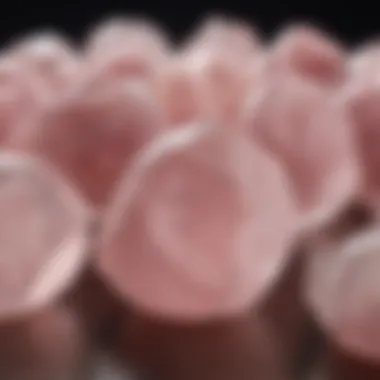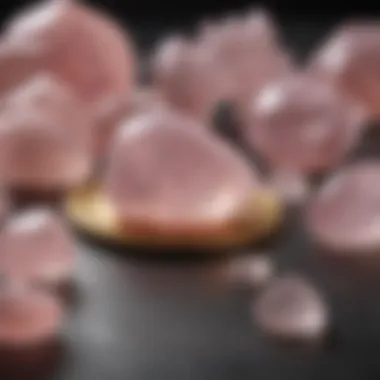Identifying Authentic Rose Quartz: A Comprehensive Guide


Intro
Identifying authentic rose quartz is a skill that benefits both novice and experienced collectors. Understanding this unique mineral beyond its aesthetic appeal provides valuable insights into geological processes and authenticity in the market. During this discussion, we will explore how to distinguish genuine rose quartz from counterfeits, as well as the importance of verifying specimens before adding them to any collection. The following sections will cover key characteristics, verification techniques, and other relevant information designed to equip collectors with the knowledge they need.
Rock and Fossil Identification
When it comes to identifying rocks and fossils, there are several aspects to consider. Rose quartz is a variant of quartz known for its pink hue, attributed to trace amounts of titanium, iron, or manganese within the crystal structure.
Types of Rocks and Fossils
Understanding the types of minerals surrounding rose quartz helps gauge its authenticity. In its natural habitat, rose quartz can often be found alongside other varieties of quartz. Additionally, it might occur in sedimentary formations, embedded in granite or metamorphic rocks.
Characteristics to Look For
Several characteristics can help in identifying genuine rose quartz, including:
- Color: Real rose quartz showcases a range of soft pink shades but should never be too vibrant or saturated. Faded hues can also indicate authenticity.
- Clarity: Unlike many adulterated stones, authentic rose quartz may contain inclusions or a milky appearance but will not be entirely transparent or flawless.
- Hardness: Utilizing the Mohs scale, real rose quartz rates a 7, meaning it can scratch glass but not easily damage with time.
Tools for Identification
Having the right tools at hand can assist in verifying rose quartz. Some essential tools include:
- A jeweler's loupe for inspecting clarity and inclusions
- A hardness testing kit to assess its durability
- Light source for examining color depth and brilliance
Collecting Tips and Techniques
For collectors, knowing how to properly obtain rose quartz specimens is important. It ensures the integrity of the collection and respects the surrounding environment.
Best Practices for Collecting
When collecting rose quartz, always remember to:
- Gather samples ethically and lawfully, respecting local guidelines.
- Document the location and conditions where the specimens are found, as this adds value to your collection.
Locating Prime Collecting Sites
Identifying locations rich in rose quartz can be challenging. Popular areas include:
- The Black Hills in South Dakota
- The Minas Gerais region in Brazil
- Certain quarries in Madagascar
How to Safely Extract Specimens
When extracting specimens, use proper safety gear such as gloves and goggles. Hand tools like small hammers or chisels are often suitable for breaking rock but require careful handling.
Preservation and Display
Once you have collected authentic specimens, preserving them properly is crucial.
Techniques for Preserving Rocks and Fossils
Keeping your collection safe from damage demands effective preservation methods:
- Store specimens in soft cloth or padded boxes to avoid scratching.
- Keep away from extreme temperatures or direct sunlight for prolonged periods.
Proper Storage Methods
Invest in airtight containers, as they protect against moisture and dust. Labels should include the specimen's origin and date of acquisition, adding historical value to your collection.
Creative Display Ideas
Displaying rose quartz can enhance its beauty. Consider:
- Glass display cases to showcase clarity and color.
- Grouping specimens with information cards detailing their characteristics.


Geological Insights
To appreciate rose quartz fully, understanding the geological context is beneficial.
Geological Formations and Processes
Rose quartz forms within igneous rocks through crystallization in the presence of heat and pressure. This process influences the final characteristics of rose quartz, affecting things like color and clarity.
Historical Significance of Rocks and Fossils
Throughout history, rose quartz held various meanings, often associated with love and healing. Ancient civilizations utilized it in jewelry and meaningful objects, signifying its importance.
Notable Discoveries in the Field
Many notable finds reveal the rich deposits of rose quartz. Discoveries in regions like Brazil or Madagascar help expand the geological narratives surrounding this mineral. Such finds frequently enhance our understanding and appreciation of rose quartz's journey through time.
Authenticity in rose quartz collecting is not just a matter of value; it's about understanding the stories behind the stones.
Understanding Rose Quartz
Understanding rose quartz begins with acknowledging its unique properties and historical significance. This section delves into the essential characteristics that define this mineral. For any collector or enthusiast, knowing these attributes is crucial for distinguishing authentic specimens from imitations. Familiarity with rose quartz can guide informed perceptions about its value, uses, and allure in the gem community.
Definition and Composition
Rose quartz is a variety of the mineral quartz, primarily composed of silicon dioxide. Its intriguing pink hue arises from trace amounts of titanium, iron, and magnesium within the crystal lattice. The specific definition of rose quartz encompasses its translucency and beautiful coloration, making it a sought-after gem. This combination of elements contributes not only to its aesthetic appeal but also to its overall physical properties, such as hardness and stability. Its desirable qualities render it a favorite in both jewelry and decorative artwork, attracting collectors and artisans alike.
Geological Origins
The geological origins of rose quartz are as varied as its uses. Typically found in granite pegmatites, it may also occur in metamorphic rocks. Notable deposits are located in countries like Brazil, Madagascar, and the United States. Understanding these origins helps collectors appreciate the mineral's journey from formation to market. Its formation through slow crystallization processes over millennia results in the beautiful varieties we see today. Familiarity with these locations can also influence collector choices, adding an additional layer of significance.
Common Uses and Significance
Rose quartz carries a wealth of cultural and practical significance. Historically, it is known as a stone of love, often associated with healing and emotional balance. Collectors admire it not only for its beauty but also for its purported properties of promoting compassion and forgiveness. In practical terms, it is extensively used in jewelry, home décor, and various crafts. For collectors, possessing rose quartz is not merely about the aesthetic; it embodies a connection to a broader narrative that spans art, culture, and geology, further enhancing its desirability.
"Collecting rose quartz is not just about acquiring a mineral; it’s about connecting with its rich history and significance."
Understanding rose quartz in this comprehensive manner enhances both appreciation and knowledge, equipping collectors with the insights necessary for discerning authenticity in later sections.
Physical Characteristics of Real Rose Quartz
Understanding the physical characteristics of genuine rose quartz is vital for accurate identification and evaluation. For collectors and enthusiasts, recognizing these traits can make a significant difference in distinguishing authentic specimens from imitations. The properties of rose quartz, including its color, clarity, luster, and durability, provide essential clues in the identification process. This section delves into these attributes, serving as a comprehensive guide for those aiming to enhance their knowledge of this prized mineral.
Color and Clarity
Range of Colors
Rose quartz is famous for its beautiful range of colors, primarily various shades of pink. This attribute is not just aesthetically pleasing; it is crucial for determining authenticity. The most common hues include pale blush, vibrant pink, and deep rose. Each shade can influence the perceived value of the stone considerably.
The key characteristic of color in rose quartz lies in its uniform distribution and depth. Authentic rose quartz showcases a consistent hue throughout the stone, whereas imitations often exhibit patches or inconsistencies. The subtle variation within genuine stones adds to their beauty, creating a unique visual signature.
However, one must be cautious of overly saturated colors, as they might indicate treatments or synthetic production. Therefore, understanding the potential ranges provides essential insight for correct identification.
Translucency vs. Transparency
Another vital aspect is the translucency of the stone. Real rose quartz tends to be semi-translucent, allowing light to softly pass through without revealing a complete transparency. This gives the stone a soft glow that many collectors appreciate. Imitation stones may be too clear or completely opaque, lacking the nuanced translucency of genuine specimens.
The unique feature of translucency sets authentic rose quartz apart, making it a preferred choice for jewelry and decorative items. However, collectors should note that not all beautiful rose quartz will be uniform; variations exist, so knowing the typical translucency levels is crucial.
Luster and Surface Texture
Types of Luster
The luster of rose quartz is typically described as vitreous. This means that it has a glassy appearance when polished, enhancing its visual appeal. The luster contributes significantly to the overall character of the stone, highlighting its beauty. Each piece can vary from dull to shiny depending on the surface treatment and quality.
In examining rose quartz, its glassy finish can indicate authenticity, provided it does not appear excessively polished or artificial. An excessively shiny surface might suggest a synthetic origin, which is a key consideration for collectors to evaluate.


Sparkle and Sheen
Sparkle and sheen in rose quartz are subtle yet paramount qualities. Real rose quartz does not exhibit the extreme sparkle found in some natural stones. Instead, it has a soft sheen that enriches its essence. This gentle reflective quality can enhance the allure of rose quartz in settings such as jewelry.
The unique feature here is the muted reflection that does not create a harsh glare. The advantages of recognizing this softness can help differentiate legitimate stones from imitations or synthetics, which tend to have a higher reflectivity. Collectors should always consider how these qualities interplay with the overall beauty of the stone.
Hardness and Durability
Measurement on Mohs Scale
On the Mohs scale, rose quartz ranks around a 7, indicating good hardness. This characteristic ensures that it withstands daily wear, making it suitable for various applications, especially in jewelry. Understanding the hardness is important for collectors who want to assess how well a piece may hold up over time.
The unique factor is that high durability means less likely to chips or scratches, making it ideal for frequent use. However, while it is relatively hard, caution should still be exercised; harder materials can scratch softer ones.
Resistance to Scratches
Rose quartz exhibits decent resistance to scratches, attributed to its hardness rating. This feature is particularly relevant for jewelry pieces that are subjected to everyday friction. The ability of the stone to maintain its integrity against common abrasive surfaces reflects its quality and reliability in use.
Collectors will find that while rose quartz can resist moderate wear, it is important to store it properly and avoid contact with significantly harder substances. An understanding of this durability helps in making informed decisions when purchasing or assessing rose quartz specimens.
A comprehensive understanding of these physical characteristics strengthens the ability of collectors to identify authentic rose quartz confidently.
Testing for Authenticity
Testing for authenticity is a crucial step when engaging with rose quartz. This process ensures that collectors can confidently identify genuine specimens, which significantly influences both the emotional value and potential resale worth. Understanding how to authenticate rose quartz can prevent costly mistakes and guarantee satisfaction in one's collection. There are several methods and techniques collectors can implement for effective verification. Each method highlights unique aspects that may point towards the authenticity or imitation of the mineral.
Visual Inspection Techniques
Evaluating Color Depth
Evaluating color depth is essential in determining the authenticity of rose quartz. Genuine specimens often exhibit a consistent and rich hue that varies from pale pink to deeper shades of rose. This specific aspect of color depth serves to distinguish natural stones from synthetics. Key characteristics include an even distribution in color, without fading or artificial layering. This method is popular because it allows collectors to quickly assess the overall quality of the stone before proceeding to more intricate tests.
Unique features of evaluating color depth include the ability to notice subtle differences that may escape the untrained eye. It’s a beneficial choice for this article, as it provides a primary visual cue that is easily accessible. However, one must exercise caution because there are imitations that replicate color depth remarkably well.
Looking for Inclusions
Looking for inclusions is another vital technique in authenticity testing. In nature, genuine rose quartz often contains microscopic inclusions, such as tiny minerals or gas bubbles. These elements contribute to the stone's character and are an indicator of natural formation. This specific aspect is significant, as inclusions can solidify its authenticity against synthetic variants, which are usually flawless and uniform.
The key characteristic of this inspection is the identification of unique patterns. Each genuine specimen tells its own geological story through inclusions, which are largely absent in synthetic stones. Its advantage lies in offering insight into the stone's history and origin, making it a favored method.
Conducting Scratch Tests
Conducting scratch tests is another practical approach to verify rose quartz authenticity. On the Mohs scale of hardness, genuine rose quartz ranks a solid 7, indicating good resistance to scratches. Collectors can use tools, such as a pocket knife, to gently test the surface. If scratches appear easily, it suggests a synthetic or lower-quality imitation. While this method may be deemed slightly invasive or risky to the specimen's condition, it provides a direct and effective demonstration of authenticity based on hardness.
Identifying Synthetic vs. Natural
Determining the difference between synthetic and natural rose quartz is a sophisticated yet necessary endeavor. Synthetics can be produced to mimic the appearance of genuine stones, often causing confusion for collectors. Thus, identifying synthetic versus natural is imperative.
Common Indicators of Synthetics
Common indicators of synthetics include uniform color and lack of inclusions. Synthetic rose quartz typically displays an unblemished surface and consistent coloration without any signs of natural imperfections. This specific aspect of recognition contributes to the overall goal of ensuring only authentic items are included in a collection. The key characteristic of this method is the immediate visual discrepancy between natural and synthetic stones.
While this method is beneficial for novices, relying solely on visual cues can be misleading due to advancements in synthetic production. Being aware of these indicators helps collectors navigate their choices more effectively.
Checking for Color Zoning
Checking for color zoning is an additional technique to ascertain authenticity. Natural rose quartz might show slight variations in color intensity and distribution, especially under magnification. This common aspect adds depth and character to the stone, making it a key characteristic in identifying authenticity. Synthetic counterparts typically lack this variance, presenting a flat and consistent appearance.
The advantage of checking for color zoning lies in its ability to reveal the subtle hues and textures of natural specimens. However, it is essential to note that some natural stones may appear uniform; hence, this method should be used in conjunction with other techniques for thorough verification.
Testing for authenticity is an intricate process, blending visual assessments and practical methods to ensure that only genuine rose quartz is incorporated into a collection. Each technique sheds light on unique characteristics that contribute to the overall understanding and appreciation of this mineral.
Tools for Verification
Verification tools play a critical role in ensuring the authenticity of rose quartz. For collectors, using the right instruments can provide clarity on whether a specimen is genuine or an imitation. Various techniques exist, allowing enthusiasts to refine their assessments. Each tool has its strengths and functions, contributing uniquely to the verification process. By understanding these tools, collectors can make informed decisions, safeguard their investments, and enhance their overall appreciation of rose quartz.


Using a Loupe or Microscope
A loupe or microscope is essential for close inspection of rose quartz. These tools allow for detailed examination that the naked eye can't capture. When using a loupe, collectors should aim to scrutinize the stone for any visual inclusions or imperfections. Authentic rose quartz may show tiny flecks or other mineral inclusions within. If the quartz appears perfectly clear without any irregularities, it could indicate synthetic origins.
Moreover, a microscope takes this a step further. With higher magnification, one can view surface textures and internal features more clearly. It’s crucial to check for characteristics like a typical "silky" luster in natural specimens. Using these devices not only reveals the stone's nature but also deepens the collector's understanding of what authentic rose quartz looks like.
Employing a Hardness Tester
The hardness of rose quartz is a vital aspect of its identity, measuring 7 on the Mohs scale. A hardness tester helps determine whether a specimen meets this standard. By trying to scratch the surface with objects of known hardness, such as a steel knife or glass, one can assess resistance. If the rose quartz scratches easily, the material may not be genuine.
Keep in mind that authentic rose quartz should withstand some level of scratching. However, common imitations often lack this durability. Thus, a hardness test is a straightforward yet effective way to validate authenticity. Collectors should be cautious when conducting this test, ensuring they use the right tools to avoid damaging their specimens.
Density and Weight Comparison
Another crucial verification method is density and weight comparison. Genuine rose quartz has a specific gravity of around 2.65. Collectors can perform a simple water displacement test to achieve this. By measuring how much water the quartz displaces, one can estimate its density. The weight of the stone should align with its size and expected density.
For collectors, this method is beneficial. If a specimen feels lighter or heavier than expected, it may raise suspicions regarding its authenticity. Collectors should always be aware of the differences in weight between genuine and synthetic stones. A careful density assessment allows collectors to further confirm their findings while enhancing their understanding of rose quartz variations.
Authenticity in rose quartz can often be determined through careful observation and testing with appropriate tools.
Challenges in Identification
Identifying authentic rose quartz can be a complex process fraught with various challenges. The market is flooded with imitations and synthetics that often bear a close resemblance to genuine stones. Understanding these challenges is crucial for collectors who aim to acquire true specimens. This section delves into the specific elements that complicate identification, offering insights to aid in making informed decisions.
Market Availability of Imitations
The sheer volume of imitation rose quartz available in the market is staggering. Many sellers offer products that, while marketed as rose quartz, may be made from glass or other synthetic materials. The high demand for rose quartz in jewelry and decor has encouraged manufacturers to create convincing replicas. As a collector, it is essential to be vigilant against these imitations.
Some common forms of imitations include:
- Glass: Often colored to mimic the hue of rose quartz, glass may lack the natural imperfections found in genuine stones.
- Synthetic Quartz: This type often exhibits uniform color and clarity, a stark contrast to the natural variations seen in authentic stones.
Being aware of these imitations assists collectors in distinguishing between authentic and fake products.
Common Misconceptions
Misconceptions surrounding rose quartz can lead to confusion and poor purchasing decisions. For instance, some people believe that all pink-colored stones are rose quartz. However, this is not true. Various minerals and synthetics can appear pink as well.
Another prevalent misconception is that rose quartz must be completely clear to be authentic. While transparency can be a characteristic in certain types, genuine rose quartz often displays inclusions or cloudiness, adding to its charm.
Acknowledging these misconceptions is vital for making sound decisions when evaluating potential purchases. It is beneficial to research and understand the specific attributes of genuine rose quartz before acquiring any pieces.
Impact of Treatment on Authenticity
The treatment of rose quartz can significantly influence its authenticity. Many stones undergo treatments to enhance color or clarity. For example, some rose quartz may be treated with heat or dyes to achieve a more vibrant appearance. Such enhancements often render the stones less authentic, and understanding this helps buyers consider their value.
Even reputable sellers may offer treated stones without full disclosure. It is important to request information regarding any treatments. Additionally, here are some common treatments to be aware of:
- Dyeing: Color enhancement through dye can cause a loss of the stone’s natural qualities.
- Heat Treatment: This process can change color but may also affect the stone’s structure and value.
With an informed perspective, collectors can make better choices about the authenticity of the rose quartz they intend to purchase.
Authenticity in rose quartz collecting is a reflection of both the mineral's natural beauty and the integrity of the collection itself.
Understanding these challenges not only equips collectors with the knowledge to identify true rose quartz but also enhances the overall experience of collecting.
Epilogue
Understanding the authenticity of rose quartz is crucial for collectors and enthusiasts alike. This article provides thorough insights into identifying genuine specimens versus imitations. Authenticity not only affects the value of a mineral but also influences its significance in various cultural, spiritual, and aesthetic contexts. By recognizing key characteristics and appropriate testing methods, collectors can make informed decisions in their pursuits.
Summary of Key Takeaways
- Characteristics of Authentic Rose Quartz: Genuine rose quartz is characterized by its distinct pink hues. Variations may occur, but deep, uniform color typically indicates authenticity.
- Testing Techniques: Employing methods like scratch tests, visual inspections, and using magnifying tools enhances the reliability of identifying authentic pieces.
- Common Imitations: Be aware of substitutes such as dyed quartz or synthetic varieties that may appear similar but vary significantly in value and quality.
- Market Awareness: Stay informed about market trends and common scams related to lime, given the increasing availability of imitations.
The Importance of Authenticity in Collecting
The significance of authenticity in collecting rose quartz cannot be overstated. For collectors, possessing authentic specimens holds immense intrinsic and extrinsic value. An original piece serves as a testament to geological history and personal investment. Moreover, genuine rose quartz often carries associated metaphysical or healing properties, which may be lost when dealing with synthetic alternatives.
In examining rose quartz, one must respect its inherent features while also recognizing the cultural narratives surrounding it. As such, understanding authenticity is not merely a technical endeavor; it involves a commitment to preserving the authenticity of the mineral trade.
"Authenticity matters. It shapes your collecting experience and establishes a connection with the earth’s geological narrative."







